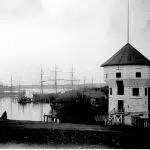Work beginning to replace rudder on troubled Bluenose II: N.S. government
LUNENBURG, N.S. — Work is underway to replace the heavy steel rudder on the Bluenose II, as the iconic schooner’s problem-plagued restoration finally appears headed toward a conclusion.
Transportation Minister Geoff MacLellan said Thursday that contracts were finalized this week with several Nova Scotia companies.
The work is starting immediately in Lunenburg, with sea trials also being done in the off-season.
The province says the bill for the overall rebuild will end up at around $25 million, following a series of technical problems, cost overruns and delays of more than four years.



